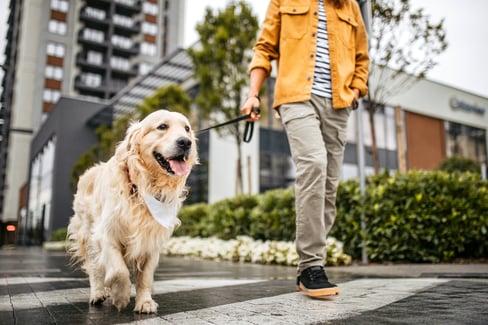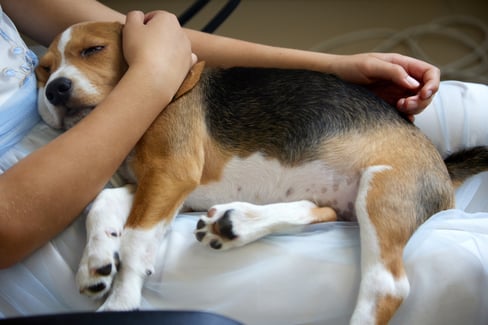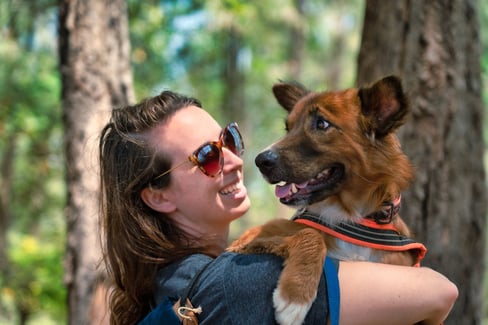Table of Contents
Nothing is lamer than your dog experiencing canine lameness.
They may be lethargic, slow, or limping around the house which is not fun to see, nor is it fun for your poor pup to experience.
The good news is that there are things you can look out for that will make sure you spot lame dog symptoms early, and ways you can prevent and treat ongoing lame dog symptoms.
In this post, we’re going to break that down and help you not only understand why your dog is lame but how you can help them by supplementing their diet with a joint health solution — so let’s get into it!
Lame Dog Meaning
So, what does it mean to have a lame dog?
If you’ve got a lame dog on your hands, it means your pup could be feeling pretty ruff.
Dog lameness refers to when your dog can’t use one or more of its limbs properly for everyday activities like walking and is often associated with an injury, surgery, or illness. One of the biggest ways you can spot a lame dog is if you see your dog limping, especially if they are usually an active and playful pup who just isn’t acting like themself. It can affect your dog from puppyhood to its golden years.
Lameness in dogs can happen for many reasons — from a strain to a broken bone to dog arthritis.
There are two categories a lame dog may fit into.
- Acute (or sudden) lame dog.
- Chronic lame dog.
If your furry friend has been showing lame dog symptoms for less than two weeks, that means they have acute dog lameness.
On the other paw, if your pup has been limping for more than 2 weeks, the vet will likely determine that it’s a case of a chronic lame dog.
The vet will also want to determine if your pup has moderate or severe lameness, depending on how much weight they can bear on the affected limb.
Common Lame Dog Types
As we said, different types of dog lameness can affect your pup. More specifically, a lame dog may have more pain in a certain area that causes them to limp.
Before we get to that, let’s get our dog-gles on and look at some basic doggy anatomy so you can see exactly where those affected areas can be for your pup.
The diagram below shows the various parts of your dog, including their foreleg (front leg) and hock and knee (hind or rear legs). These areas are generally where a lame dog can be affected.
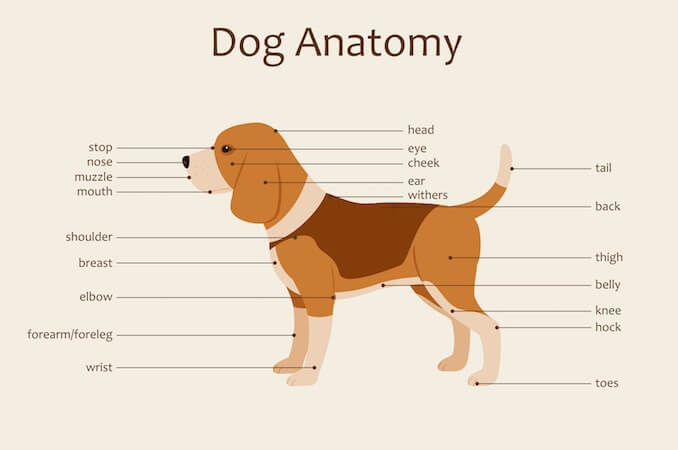
Dog Lame Back Leg or Hind Leg
Is your dog showing signs they are favouring their front legs? Maybe it seems like their hind legs are dragging behind them a bit more than normal?
If their forelimbs (or front legs) are what they are leaning on most of the time, your pup might have a lame dog leg — specifically on one or both of their hind legs.
Hip dysplasia can be a big reason for this kind of lame dog problem. Hip dysplasia is a condition that happens when the ball part of your dog’s ball and socket joint (located at the end of their femur) doesn’t form properly. Since the ball doesn’t fit properly into the socket and is loose, irritation, discomfort, and those pesky hip dysplasia symptoms occur.
Another reason you could have a dog with a lame back leg is due to a degenerative disease that affects a dog’s spinal cord called degenerative myelopathy. It is similar to the human disease ALS.
It results in your puppy’s hind legs getting progressively weaker and eventually, paralyzed. Unfortunately, it is not known what causes this paw-ful condition. It can present itself more like arthritis, so if you’re seeing your pup experiencing these kinds of symptoms, you will want to see your vet as soon as possible to see if you have a lame leg dog on your hands and determine the exact cause of the lame leg.
Dog Lame Front Leg
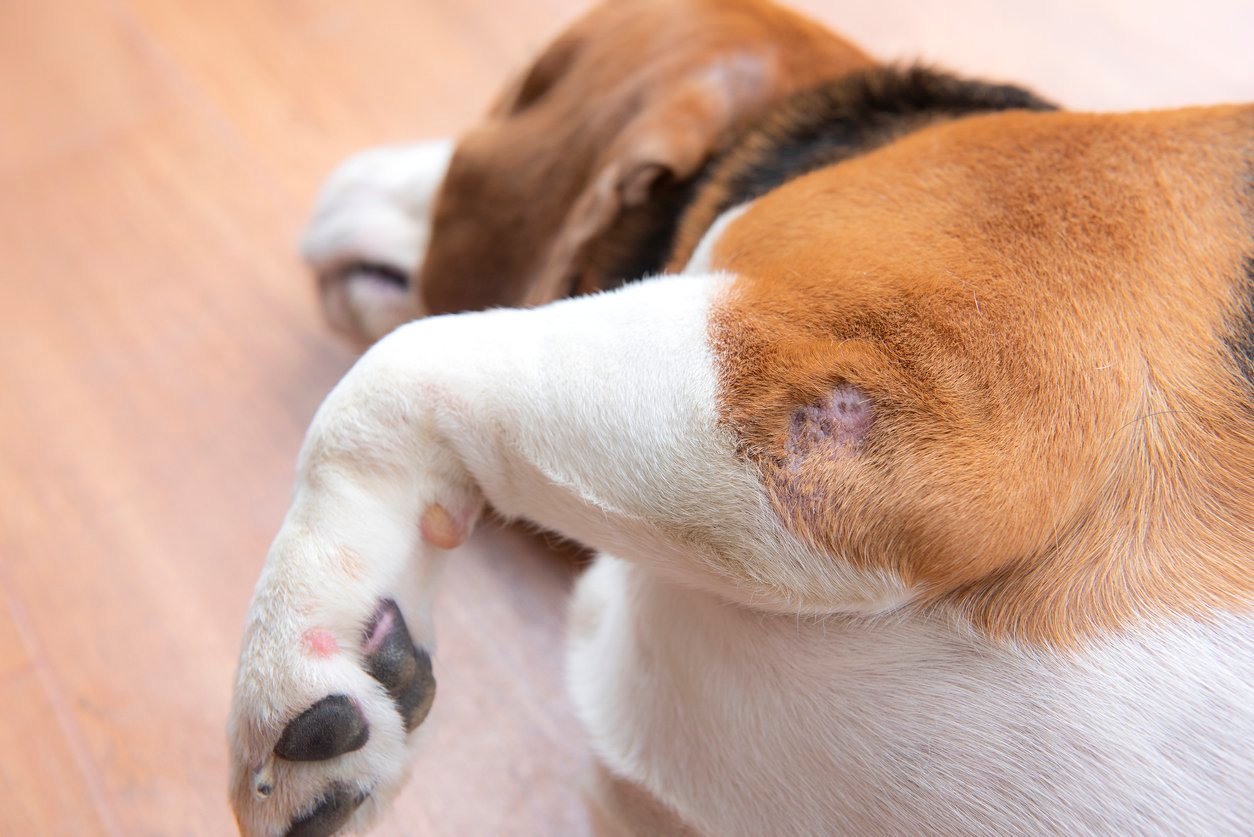
If it’s not the dog’s lame hind legs that are bothering your canine companion it may be that your dog has a lame front leg.
If you suspect that your dog’s front leg may be injured, watch for them to favour back legs and avoid putting weight on their forelimbs.
Another thing to watch for is if they raise their head and perk their ears when the affected front leg touches the ground unexpectedly while walking. If they bear weight on their lame front leg while getting up from the ground, you might notice they lower their head, kind of like how we would kneel ourselves when we’re hurt and trying to move around.
A dog’s lame front leg can be caused by a variety of things including:
- A sprained wrist.
- The condition canine carpal hyperextension.
Just like in humans, the dog’s wrist (situated on the front leg below the elbow) is especially prone to a sprain. It usually happens when they jump down from somewhere and land poorly on their wrist.
Canine carpal hyperextension, on the other hand, is what happens when excessive force or strain occurs in the carpus. The carpus is located on your puppy’s front leg above the top of the paw.
This kind of strain commonly happens when your dog faces a more serious fall from a greater height, so keeping an eye out when your dog decides to climb and explore is a good idea to prevent this kind of lame dog injury.
Sudden Lame Dog
Imagine this: you’re out for a hike with your favourite furry companion, and suddenly they let out a yelp and begin limping right away.
Not good, right?
This kind of lame dog behaviour can be seen as sudden dog lameness.
Usually, sudden dog lameness is caused by an injury, cut, or bite from another animal or insect, or some sort of other trauma that has your pup exhibiting lame dog symptoms all of the sudden.
If lame dog symptoms are present, heading to the vet right away to find out what’s bothering your dog is the best way to make sure they are back on their paws in no time.
Causes of Lame Dog
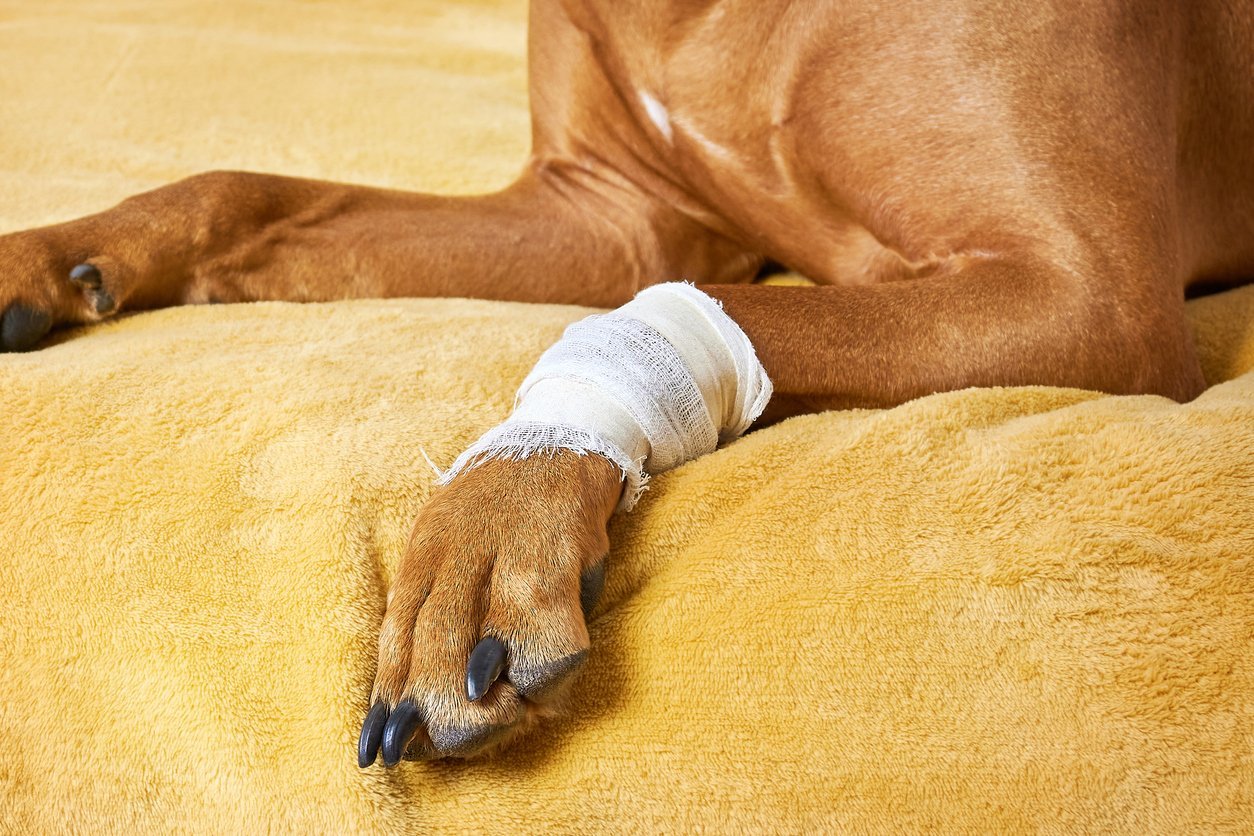
Now that we’ve talked about how a lame dog can present itself to you as a pet paw-rent let’s dive into what the causes of a lame dog can be.
1. Injury
First up as a cause of lame dogs — injury.
Just like us, our dogs are prone to accidents now and again.
Everyone makes mistakes, but sometimes those missteps can cause problems like ligament strains and injury to happen to your dog.
Common kinds of ligament strains and injuries can cause lame dog symptoms, like:
- Dislocation of one of their joints, such as a hip, where the joint is not articulating properly
- A sprain or strain, which is a kind of soft tissue injury
- A muscle or ligament tear, like a cranial cruciate ligament (CCL) tear, is similar to the ACL in humans
- A luxating patella, which is when your pup’s patella slides out of place (You may notice they have a ‘skipping’ kind of lameness as your dog only feels pain when the patella slides out of the joint)
Lameness from these kinds of injuries is less easy to spot since it’s not always obvious.
Opposingly, an external injury can be easier to spot.
An external lame dog can be identified by things like:
- A cut or laceration to one or more of their paws
- An object stuck in their paw, such as a thorn
- A bite from an animal or insect
Always check their legs and paws for injuries like these if you spot bleeding, or notice them limping and consult your vet if you’re seeing these symptoms persist.
2. Other Lame Dog Conditions
Aside from an injury, your pup can experience dog lameness from specific conditions that cause pain and inflammation in their joints including arthritis and hip dysplasia.
Arthritis is a degenerative joint condition that commonly affects senior dogs, but it can onset at a younger age, too. Joints consist of bones and cartilage. Cartilage provides cushion for bones and a low-friction environment for fluid movement. When your dog has arthritis, its bones rub against the cartilage. Eventually, it wears the cartilage down, which ends in painful bone-against-bone friction for your poor pup.
The pain of bones rubbing together will lead to some lame dog behaviours like limping, inability to jump up, and struggling to pick themselves up off the floor.
Another common condition that leads to dog lameness is hip dysplasia.
Like we mentioned earlier, hip dysplasia is a deformity of the hip that typically occurs during growth. While larger dogs like German Shepherds have more of a genetic predisposition for this condition due to their size, it can also develop in smaller dogs such as French Bulldogs and Pugs. Overall, it affects 16% of dogs, making it a pretty common problem that leads to a lame dog.
Signs of a Dog Going Lame
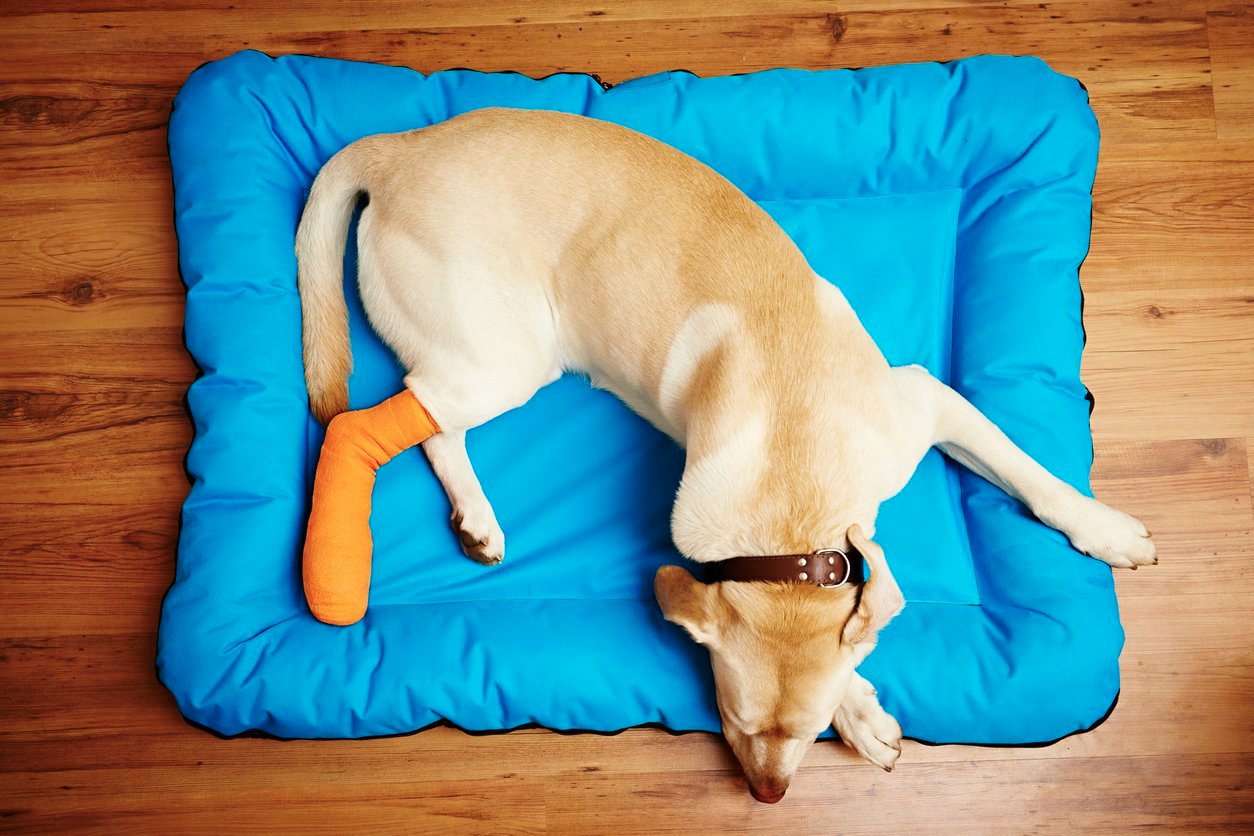
It’s important to know what to look for when you think you might have a lame dog.
While no two dogs are the same, there are common signs of lameness in your pup to look out for that can make sure you catch a potentially dangerous condition early, and prevent your pup from further pain.
If you suspect that you have a lame dog, you may notice they are:
- Suddenly not wanting to move or showing unwillingness to get up.
- Trembling, vocalizing (whimpering), or showing other signs of fear and pain.
- Bleeding profusely and suddenly.
- Showing noticeable swelling in one or more limbs.
- Dealing with an obvious fracture or broken bone (visible to you).
- Dragging their fore or hind legs.
- Experiencing a fever (any temperature over 103.5° Fahrenheit)
- Showing other unusual behaviours or signs of illness (like vomiting, lethargy, or unusual bathroom habits).
Symptoms like dragging limbs, swelling, and bleeding need to be taken the most seriously. If you notice these or any other out-of-character behaviours for your dog, call your veterinarian immediately.
Prevention Options for Lame Dogs
It’s obvious that if your dog is lame, they probably aren’t having a great time. And nothing is more ruff than seeing your beloved companion in pain.
How can you prevent your pup from lame dog symptoms?
While nothing is guaranteed, there are six key things you can do to make sure you’re pup-ared for lame dog prevention:
- Manage your dog’s weight
- Incorporate a joint health supplement into their diet, such as TRI-ACTA and TRI-ACTA H.A.
- Ensure they exercise regularly
- Observe them carefully when they’re exploring and playing
- Give them grips in your home to avoid slipping and sliding
Now let’s get into these precautions in some more detail so you can keep your pup safe from showing signs they are dealing with dog lameness.
1. Manage Weight
Did you know that 50-60% of pets in Canada are considered to be obese?
As much as a pudgy pup can be adorable on the surface, it isn’t good for their health.
The more weight your dog is bearing on their limbs, the likelihood of them getting arthritis increases. As we’ve mentioned, osteoarthritis is one way a lame dog can appear.
Ensuring your dogs are on a weight-management plan can help reduce the likelihood of developing lameness.
A weight management plan should include:
- Proper exercise
- Not overfeeding treats
- Sticking to low-calorie treats
- Measuring their food intake
- Using specific diets to control weight
2. Incorporate Joint Supplements

There’s nothing that guarantees that your dog won’t experience lameness at some time.
But one thing that can make a huge difference in the prevention of lame dog symptoms is joint supplements.
Since they promote overall joint health, supplements like TRI-ACTA and TRI-ACTA H.A. work wonders in trying to prevent or reduce the symptoms of arthritis. Key ingredients like glucosamine, chondroitin, and MSM each play a key role in fighting joint degradation and inflammation, which is a great way to set your dog up for success in fighting lameness.
By improving the health of your pup’s joints, they are less likely to develop conditions that lead to a lame dog, and if they do get a strain or sprain, they likely will be able to bounce back faster than you can say ‘fetch!’.
The table below breaks down some of the key ingredients you should look for when reading a joint supplement label, so you can make sure your pup is getting exactly what they need and no fillers.
| Joint Supplement Ingredient | Benefit |
| MSM | Reduces pain and inflammation in the joints. |
| Chondroitin | Prevents cartilage from breaking down or deteriorating. |
| Glucosamine | Helps the production of proteoglycans, which in turn helps repair cartilage in your lame dog. |
| Hyaluronic Acid | Creates improved viscosity of the synovial fluid, making joints more lubricated and therefore more mobile. |
3. Exercise Regularly
Remember that whole exercise thing we mentioned earlier? Let’s talk more about why that can help prevent dog lameness.
Not only is it important for weight management, but regular exercise is also important for keeping your pup’s health in tip-top shape.
Regular exercise for your dog is important for keeping muscles, tendons and ligaments in good working order. Regular exercise means if they do take a tumble, their body is in optimal shape to handle it.
Just be careful to match the type and amount of exercise you are giving your pet with what their needs and age are. Opt for age-appropriate activities that get your pup moving.
4. Observe Carefully
Ever turned your back on a pet, and they’ve managed to have gotten into a bind in a matter of seconds (or so it feels)?
Not only will observation save you from cleaning up an unexpected mess, but keeping a close eye on your dog while they are playing, running around, or even walking alongside you can prevent them from pulling, straining, or tearing a muscle.
Some examples of key times to monitor your dog especially closely are:
- Outdoor play on uneven terrain
- Playdates with other dogs
- Indoor play with toys or people
- When they are running or jumping
- When taking a long walk on asphalt or concrete surfaces (they tend to be harder on doggie joints)
5. Give Your Dogs Grip
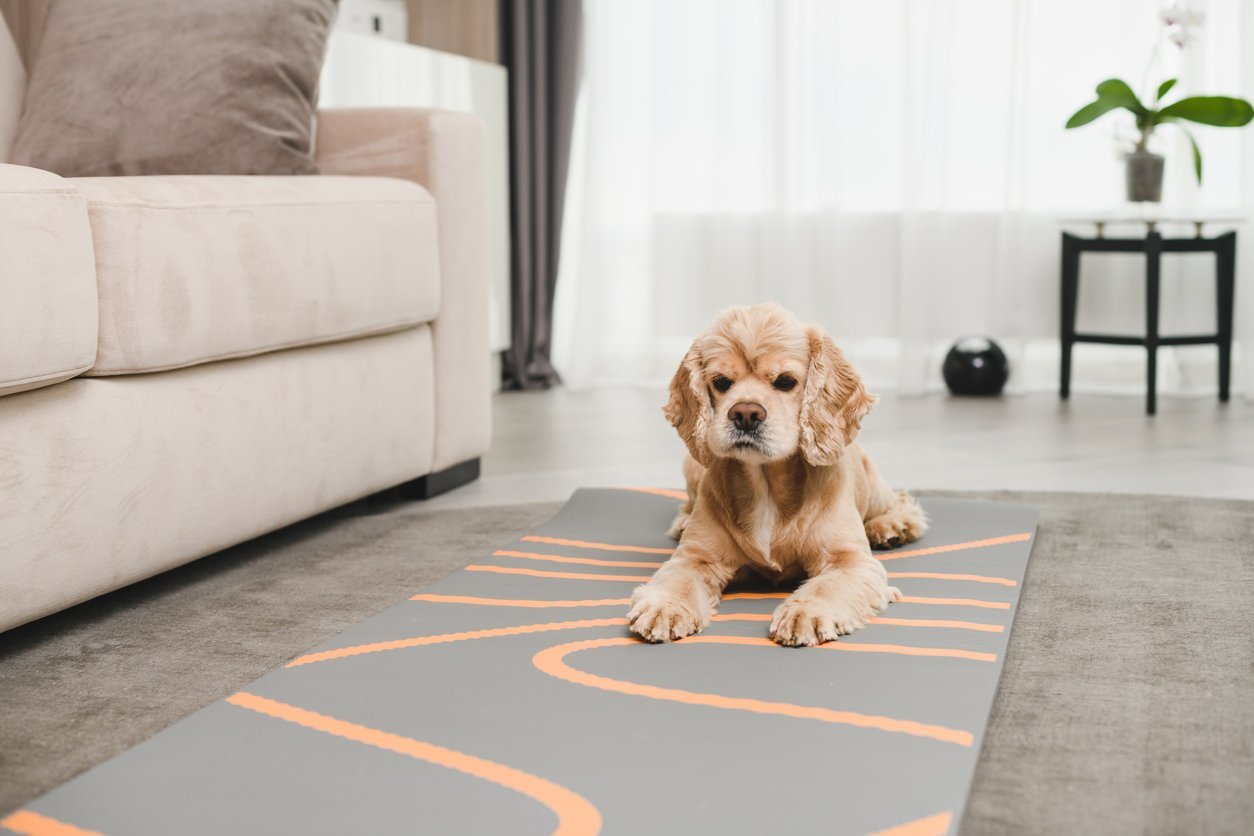
Shiny hardwood or tile floors plus your dog when they get the zoomies? That equals a recipe for disaster!
As much as cleaning hard surfaces is easier than carpet, especially with a dog in the house, you need to make sure your pet can get the grip they need to avoid sliding and slipping around. Often, slippery surfaces like tile, laminate, and hardwood can be hard for dogs to get traction as they use their nails to grip.
Adding rugs or carpet tiles throughout the house (especially on smooth stairs) and avoiding playing with your dog on shiny floors they can’t get a grip on is one way to prevent injuries that will make for a lame dog.
Treatment Options for a Lame Dog
Prevention is the best medicine in our books.
Sadly, there are no guarantees your dog won’t take a spill and sprain their wrist or develop a breed-specific condition that makes a dog lame.
That being said, lame dogs can be treated with a variety of methods that work on their own or with each other to get your pup feeling better in no time.
1. Medication (NSAIDs)
Nonsteroidal Anti-Inflammatories, or NSAIDs, are common treatments for both human and dog inflammation and pain.
When your dog is lame, it means that there’s inflammation in limbs, paws, or joints that needs to be brought down for them to feel some relief.
The good news is that NSAIDs are perfect at doing just that, and there are plenty of options your vet can prescribe, such as:
- Carprofen
- Deracoxib
- Firocoxib
- Meloxicam
Be careful though — only give your pup medications prescribed by their vet. Human NSAIDs can be toxic to dogs. The Pet Poison Hotline gets about 4000 calls per year for Ibuprofen poisoning in dogs. So stick to what the doctor ordered, and when in doubt call your vet.
2. Home Modifications
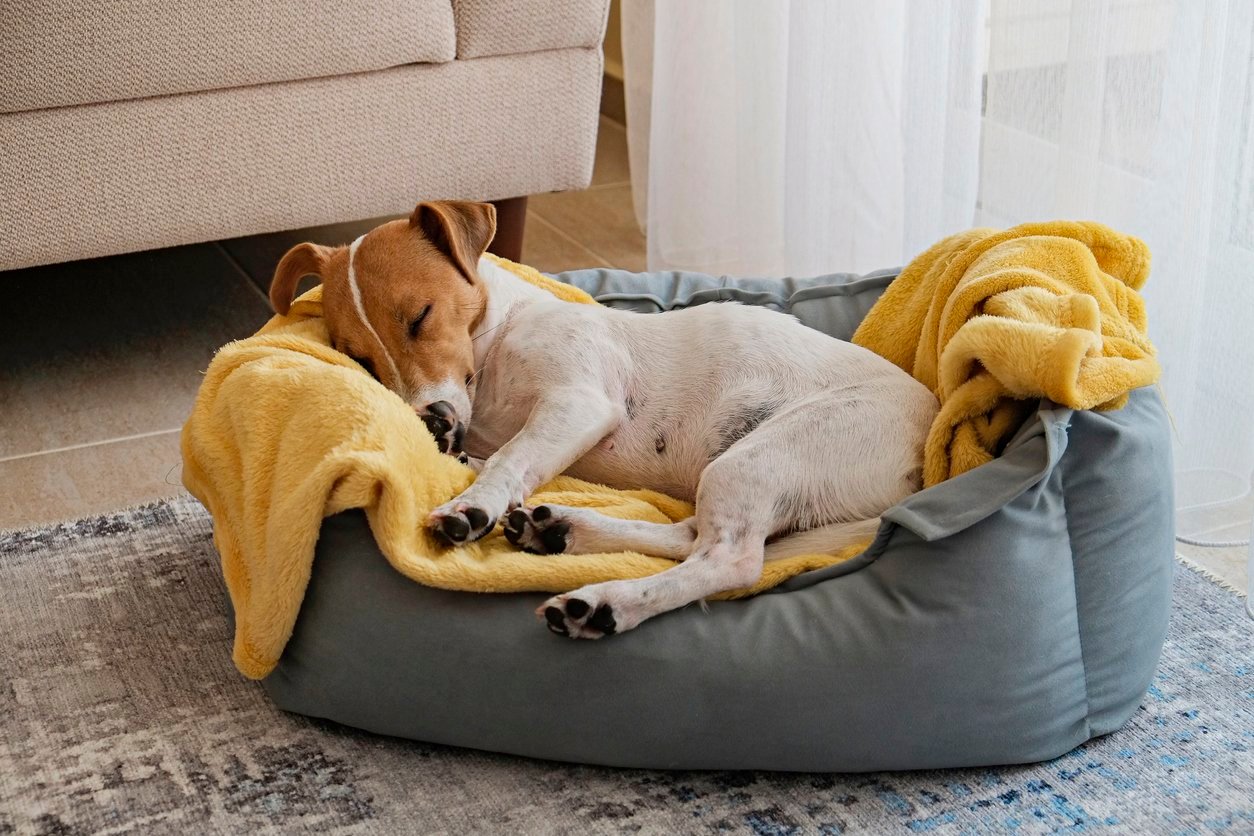
If your dog has been showing signs of lameness, you’re going to want to make sure your home is suitable for their needs.
Ensuring they have a soft, cozy orthopedic dog bed can help cushion sore joints and support your dog while they do their favourite thing — sleep.
Also pup-ular in doggie ergonomics is elevated feeding bowls. They allow big dogs to bend over less while eating, which is especially great if they have arthritis.
Another aspect to consider when modifying your home to suit a lame dog is if they like to jump up and down when getting in and out of bed or on and off the couch. If they (and let’s be honest, you) love cozying up on the furniture together, buying a ramp to help them up and down instead of them needing to jump can be much easier on their joints.
3. Joint Supplements
Joint supplements are not only great at helping prevent some of the conditions that lead to a lame dog, like arthritis, but they can also ease the pain when your lame dog is experiencing symptoms.
Key ingredients like MSM, glucosamine, and chondroitin can really speed up the healing process for your pup if their lameness stems from a strain or tear. Add in the lubricating qualities of hyaluronic acid and you’ve got the recipe for a happier, healthier pup whose joints are feeling the effects of reduced inflammation and better mobility.
4. Surgery
Sometimes, surgery is the best option for treating a lame dog.
If your pet has hip dysplasia, or they have torn a ligament or broken a bone, surgery will often be the solution that works best to help make sure they can get back on their paws in no time.
In order to determine if surgery is the answer to your lame dog, your vet will conduct a thorough examination and likely some X-Rays to see what exactly the cause of your dog’s lameness is.
Top 3 Dog Supplements for Canine Lameness
Integricare’s TRI-ACTA H.A.
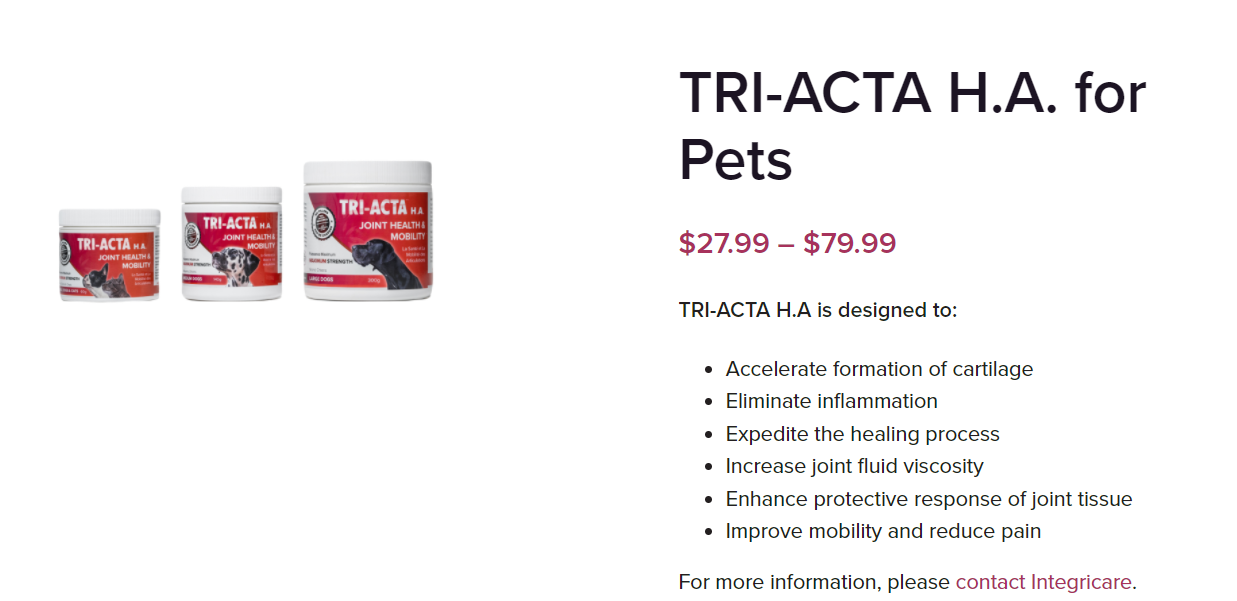
Could we really write this list of joint supplements that help with a lame dog without including our own?
Integricare’s TRI-ACTA H.A. is specifically formulated to:
- Accelerate formation of cartilage
- Eliminate inflammation
- Expedite the healing process
- Increase joint fluid viscosity
- Enhance protective response of joint tissue
- Improve mobility and reduce pain
In short, that means a ton of joint health helpers are packed into a therapeutic dose that’s easy to administer to your pup since you just sprinkle a small amount over their food.
Oh, and did we mention it also offers two forms of glucosamine, too?
The table below outlines the different forms of glucosamine in our blend, and why they are beneficial to your pet.
| Form of Glucosamine | Advantage |
| Glucosamine Sulfate | Sulphur is an essential nutrient for joint tissue and is needed by the body to produce cartilage. |
| Glucosamine Hydrochloride | Is more concentrated than the sulphate form of glucosamine because it is naturally stable. This means it is more absorbable. |
* Priced $27.99 – $79.99 CAD as of January 2022
Naturvet Glucosamine DS Plus MSM & Chondroitin Soft Chews
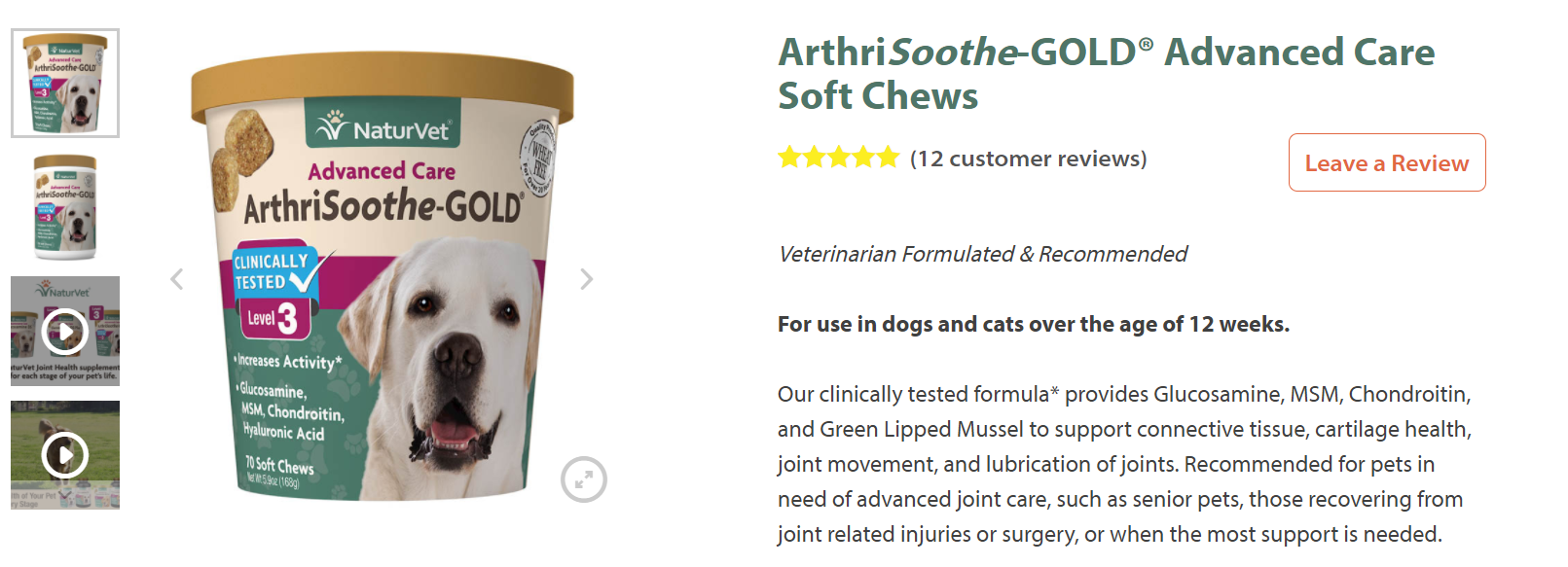
Our next pick for a supplement to help with a lame dog is Naturvet Glucosamine DS Plus MSM & Chondroitin Soft Chews.
These chews are perfect for senior pets who are showing signs of lethargy and severe joint pain due to lame dog symptoms or surgery. They were shown to have 2.6 greater odds of showing an increase in activity after 25 days. Plus, they have other options (Level 1 and 2) that are aimed at younger dogs seeking prevention of lameness later in life.
One thing to watch for in this formula — the fillers. Unfortunately, most treat-style supplements are formed with fillers like glycerin, lecithin, and maltodextrin and this option is no exception.
* Priced $49.81 CAD as of January 2022
Nutri-Vet Hip & Joint Level 3
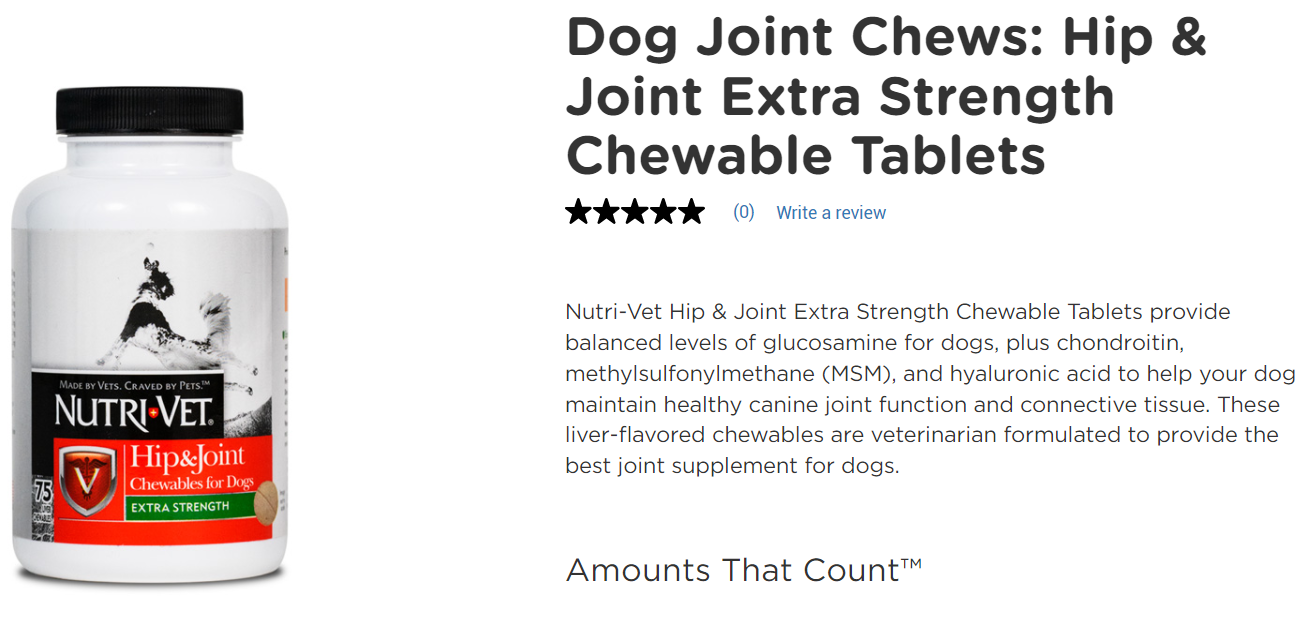
Last on the list is Nutri-Vet Hip & Joint Level 3.
Another chewable option aimed at the senior pup-ulation, this option for preventing dog lameness also offers a bonus dose of vitamin C, manganese, copper, and zinc to make sure your canine is in tip-top joint shape.
Unfortunately, the reviews are mixed when it comes to flavour, so the jury is out on whether your pup will find this to be palatable enough to eat.
* Priced $19.70 – 24.24 CAD as of January 2022
How to Get Started with Maintaining Dog Joint Health
Whether your dog is lame due to injury, or a chronic condition, you can help them in a variety of ways.
You can also work on prevention through a variety of techniques, including adding a joint supplement to your pup’s daily regimen.
That way, when your pup does take a spill, faces arthritis, or is recovering from an injury, you can be confident that their joints have been supported and that the effects of the injury are mitigated.
And the best option for supplementing a lame dog’s joint health? TRI-ACTA H.A.
Our maximum strength supplement offers all the benefits of our regular formulation of TRI-ACTA, with the added bonus of hyaluronic acid for improved joint lubrication and mobility.
TRI-ACTA for Pets
A proactive approach for developing and younger adult pets to maintain optimal joint health mobility, minimize inflammation and fend off age-related ailments.
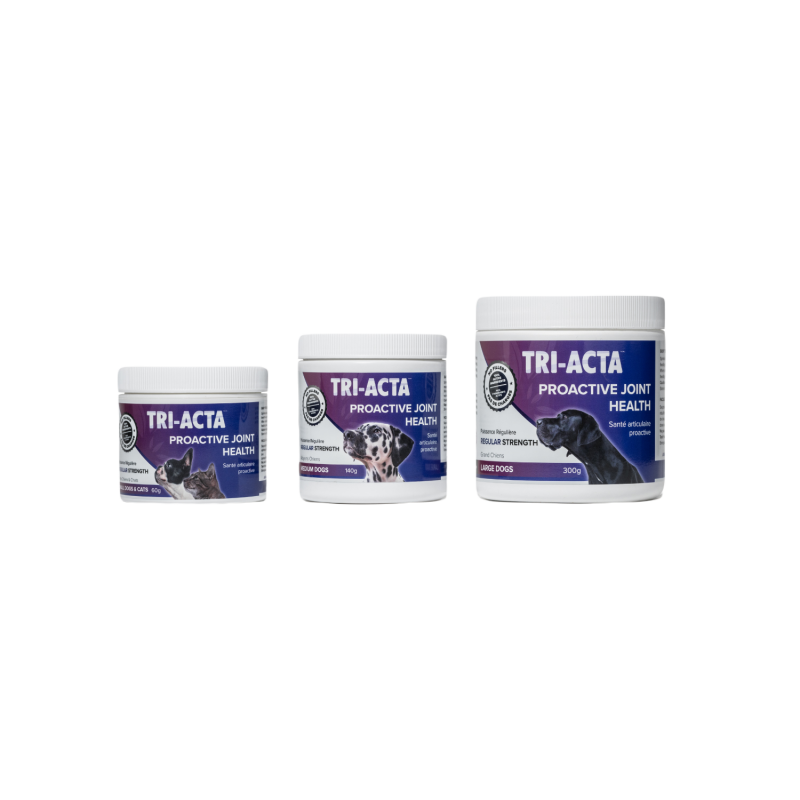
So don’t wait to start helping your pup prevent and treat their lame dog symptoms — use the information from this post to go forth and protect your dog from canine lameness.
Newsletter Signup
Subscribe to our newsletter to receive the latest news and exclusive offers.
.jpg?height=2000&name=Cliick_Integricare-DISPLAY-REVISEDV2%20(1).jpg)
Proactive & Therapeutic Joint Supplements
When given daily, Integricare joint supplements recover bone and joint injuries faster and help prevent mobility injuries from happening in the first place.








